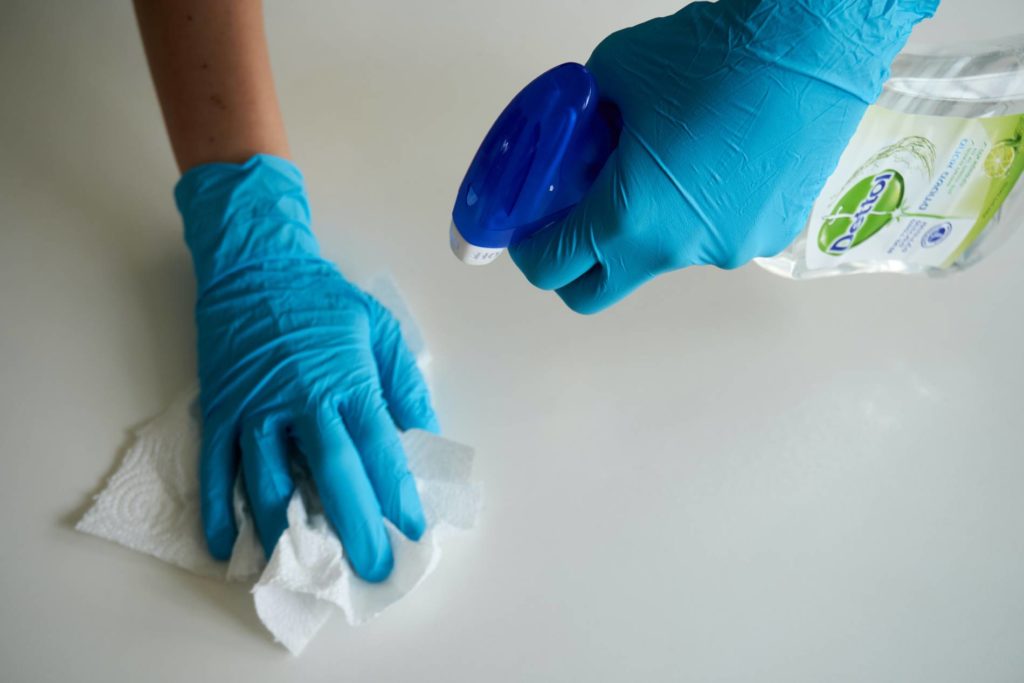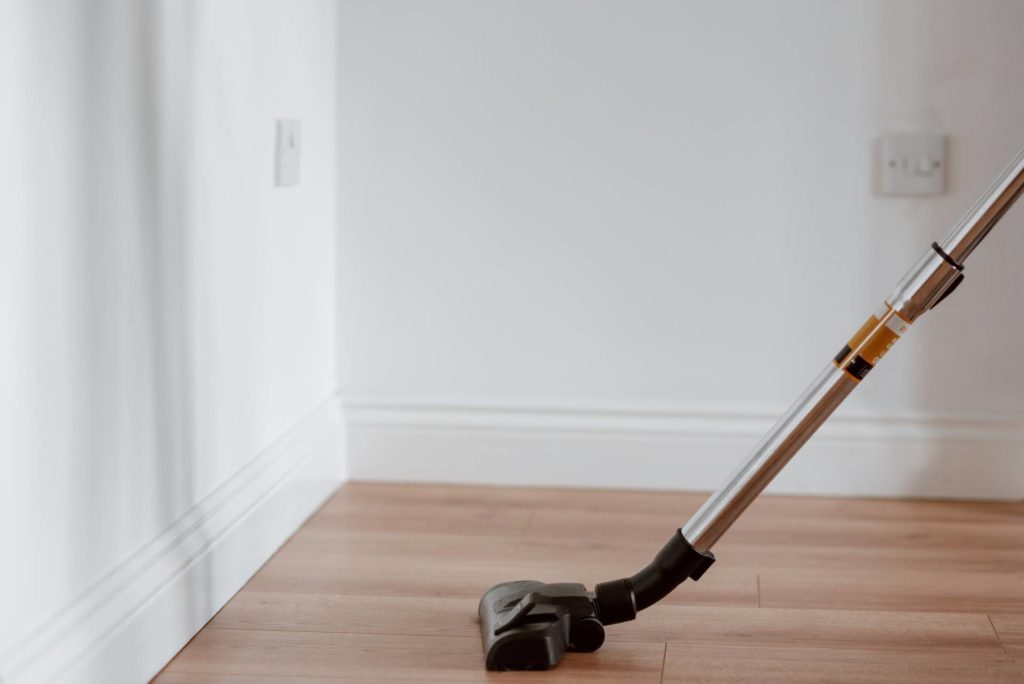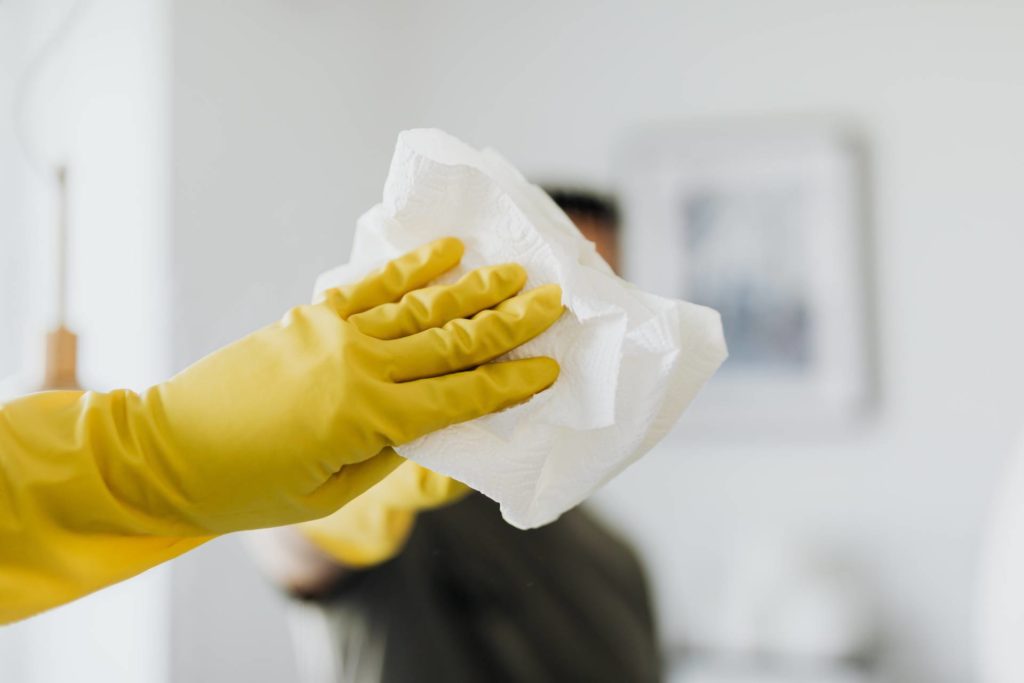
Moving into a new home is an exciting time. However, before you get settled in, your new house will also need a good deep cleaning. But where to begin? With an empty house, now is the time to roll up your sleeves and deep clean your home right the first time. This article will go through all the supplies you’ll need along with tips straight from our professional cleaners at ProStar Cleaning.
Everything You’ll Need to Clean A New Home
Before we share all our cleaning tasks and tips, here are the tools, equipment, and supplies you will need to clean your home.
Tools & Equipment
- Spray bottle
- Bucket
- Toilet brush
- Broom
- Vacuum
- Dust mop
- Duster
- Step ladder
Cleaning Supplies
- Rubber gloves
- Abrasive and non-abrasive sponges
- Cleaning rags/microfiber cloths/paper towels
- Cleaning brush/old toothbrush
- All-purpose kitchen/bath cleaner
- Chlorine-free bleach
- Baking soda
- Liquid dish detergent
- White vinegar
- Wood-cabinet cleaner
- Window cleaner
- Floor cleaner
- Toilet brush
- Toilet cleaner
- Carpet cleaner
- Degreasing cleaner
Optional cleaning supplies include:
- Tile/stone cleaner
- Wood soap cleaner
- Oven cleaner
- Chlorine bleach
- Cleaning erasers
General House Cleaning Tips
Before we dive into our specific cleaning tips, here are some general cleaning tips that apply to all of the rooms in your house.
Where to Start?
Bathrooms often take the longest to clean so they make a great starting spot. Next work on dusting using the top-to-bottom method, followed by vacuuming. Dusting from the ceiling to the floor will prevent you from having to clean things twice once the dust settles. Start from the highest points in your house, such as the tops of cupboards, ceiling fan blades, light fixtures, vents and even the tops of door frames and then work your way down. Then work on the kitchen and finish up with washing all hard surface floors on hands and knees.
Cleaning the Walls
Next, let’s tackle the walls. Use a flat mop to clean walls; this method works well without leaving marks on the walls. Combine a mixture of water and a drop or two of dish soap and clean from the bottom to top in up and down motions. This will prevent any streaking. Use another towel with water before drying off the area to ensure no residue is left over. If needed, use cleaning erasers to remove leftover streaks.
Cleaning Exterior Doors
Move-in time is a great time to clean the outside of your exterior doors. This is one area most people don’t think to clean. The previous owners may have overlooked this step, but it’s good to add this to your cleaning checklist. Your front door is one of the first things people will see. Make an excellent first impression on your neighbours by wiping down your doors inside and out.
Tips for Cleaning the Bathroom
Now, let’s head to the bathroom! This can be one of the toughest rooms to clean when you’re moving into a new home, especially if the previous owners didn’t clean their bathrooms regularly.
Cleaning Mirrors
It’s time to clean your mirrors. Here’s another method coming straight from the pros.
Before you get started, turn off the lights and make sure they are cool. Once the lights are cooled down, start by washing the lights above the mirror. Then spray the mirrors from top to bottom to prevent the chemical from dripping down and streaking. Wipe the mirrors with a dry cloth from left to right in straight overlapping strokes, working from top to bottom until all of the glass cleaner is removed and your mirrors are streak-free. Once you’re done, turn on the lights and check your work to make sure your mirrors are shining like new!
Cleaning the Bathtub & Shower
To clean any stains off of porcelain tubs (or even porcelain sinks), we recommend using the following methods.
For lightly soiled baths and showers, use a multi-purpose shower cleaner. Spray it on from bottom to top (this prevents streaks) and leave it on the surface for a few minutes. Use a nylon scrub brush to agitate any areas that need it, and then dry with a microfibre cloth.
For heavier staining on glass and acrylic, try an acid-based cleaner. Be sure to check that your cleaner won’t damage the surface you are using it on.
For stains involving porcelain, try using a cream-based cleanser. Make sure to allow some dwell time for stains to loosen before scrubbing with a nylon scrub sponge.
Cleaning the Toilet
Use a toilet brush and toilet cleaner to scrub your toilet. Use a disinfectant cleaner and cloth for the toilet seat and all outer areas. Just make sure to clean the toilet last and then put it straight in the laundry once you’re done.
You can use pumice stones for the rings in the toilet and around the base of the toilet. You can disinfect your pumice stone between uses by spraying it with your disinfectant cleaner and letting it sit for a few minutes between uses.
Tips for Cleaning the Kitchen
Now it’s time to deep clean your new kitchen.
Cleaning Cabinets
When cleaning the kitchen, it’s a good idea to work from top to bottom and from the inside out. You will need your step ladder to reach some of the areas. Use caution when standing on countertops as they could become damaged/cracked from walking on them. Have your grout brush or toothbrush ready to help you get in the backs and corners of cabinets, and don’t forget to wipe the style (the bar that runs down the middle).
If you’re looking to be a bit proactive with your cleaning, another great tip is to cover the tops of your cabinets with parchment paper. Then you can simply remove the paper when it gets dirty and replace it with new paper, so you never have to worry about cleaning the tops of your cabinets again!
Cleaning Cooktop Stove
Cleaning stoves can be a bit tricky, so here’s a tip to make it easier. For heavily soiled or stained cooktops, a cream-based cleanser can be a good option. Apply the cleanser and use a nylon brush to cover the surface and agitate. Leave some dwell time for the product to loosen stains and then agitate further. Use a wet cloth to remove the cleanser and shine with a glass cleaner when completed.
Cleaning the Oven
Now that the stovetop is clean, let’s move on to the oven.
For the inside, use a vacuum to suck up any debris. Run the self-cleaning cycle if this option is available. If not, use an oven-cleaner and follow the instructions on the label. If you spray an oven with oven cleaner, you can remove the oven door and place it on plastic garbage bags or paper (did you know oven doors are easily removed?) Thoroughly protect the surrounding cabinets with newspaper and tape, open a window and turn on a fan to ventilate the area. If using oven cleaner, it’s also important to wear PPE.
To remove fogginess on the window, apply glass cleaner to a cloth.
Cleaning the Fridge
Before cleaning the fridge, remove all items. You can wash the bins and shelves in soapy water and use a neutral cleaner on the inside of the fridge. A vinyl scrub brush is good for cleaning the racking, and a grout brush works well for cleaning hard-to-reach areas.
Note: it is not necessary to unplug your fridge to clean it, but if you do, make sure to never leave an unplugged fridge with the doors closed as this will ruin the fridge. If you have to leave a fridge unplugged, prop the door open securely. It is a good idea to put a reminder note for others not to close the door.
Cleaning Stainless Steel Appliances
You can buy cleaners made specifically for stainless steel appliances that will help to repel fingerprints. Spray the cleaner on the surface and wipe using a microfibre cloth to shine the surface, moving with the grain of the stainless surface in straight overlapping strokes. Note: you don’t need to rinse the cleaner off after. It’s like a glass cleaner in that you just need to spray and dry the surface to make the stainless steel shine.
Avoid using cream cleansers on stainless steel appliances and this will ruin the stainless. However, you can use a cream cleanser on your stainless steel sink because it doesn’t have a shiny finish.
Other Areas
The kitchen has many areas that can often be overlooked. Here are some other areas in your kitchen that you should add to your cleaning checklist. This includes:
- Behind major appliances
- Bottoms of drawers
- Inside the pantry
- Under the sink
- Tops of cabinets
- Around light switches
Tips for Cleaning the Carpets

All sorts of debris get trapped deep inside carpets, meaning your carpets are they’re likely due for a thorough cleaning. If your house doesn’t have carpet, you can skip this section.
Professional Carpet Cleaning
If your carpets need a deep cleaning, call the professionals at ProStar or book online and we can help. At ProStar, our steam cleaning services include carpets, area rugs, upholstery cleaning, and spot and stain removal. Sit back and relax while we get to work! Our trained professionals guarantee a Job done right® every time. We start by pre-treating any stains and high traffic areas. Then we conduct a hot water extraction (steam clean). Next, we will use an acid rinse application (PH-neutralizing bonnet cleaning). Once the post-cleaning inspection is complete, your carpets will look brand new.
Keep in mind that some carpets are simply unsalvagable. If the previous owner had pets and your carpet has a lot of pet stains, you may just need to replace the carpet altogether.
Trust Calgary’s Best Cleaning Company to Clean Your New Home

That’s a wrap on how to deep clean a house before moving in. With that said, deep cleaning your new house takes a lot of time and effort. It can be hard to find time to clean while trying to unbox all your belongings and settle into a new environment.
Instead, let ProStar do all the cleaning for you. We pride ourselves on always doing a Job done right® and on setting the highest standard for quality. Learn more about our ProStar Move-in & Move-Our Cleaning Services, and book online today.